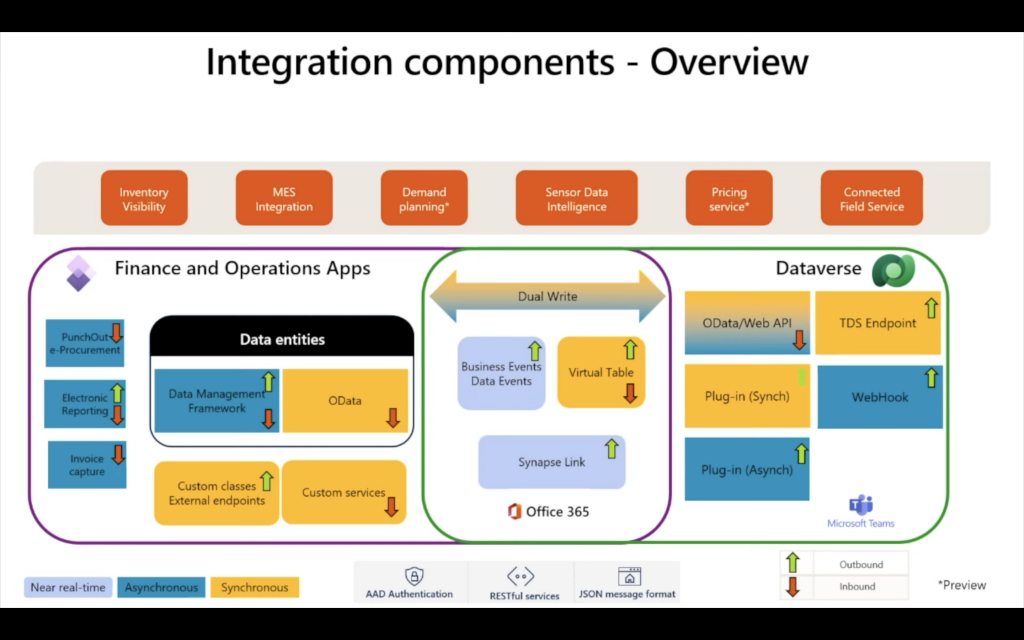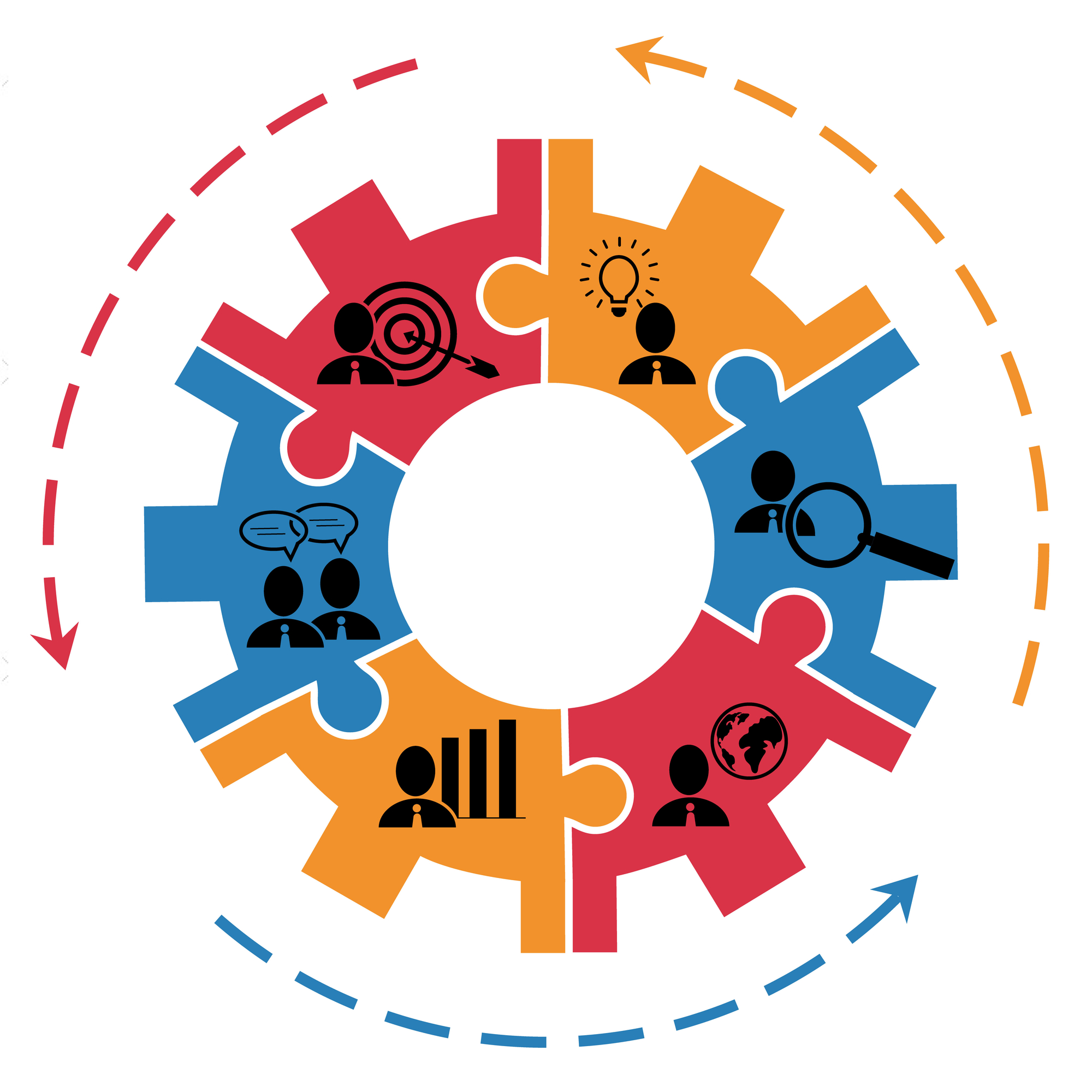In this article, we will delve into the details of integration strategy patterns, tools, and concepts for Dataverse and Dynamics 365 Finance and Operations applications. Our focus will be on providing an introductory overview that offers a comprehensive look at the main components of the integration landscape.
We will then proceed to explain the fundamental principles that should guide integration design; the primary integration patterns and the factors that should influence pattern selection.
Introduction of the Integration
Dataverse and Dynamics 365 applications offer a diverse range of integration options to address various business and technical scenarios. These different approaches allow for flexible designs that can increase automation, optimize processes, reduce costs, and enhance security.
At a high level, integration options can be grouped based on the applications they are designed for:
- Dynamics 365 for Finance and Operations Apps (e.g., DMF).
- Dynamics 365 for Customer Engagement / Dataverse (e.g., Plug-ins).
- Both (e.g., events).
Another popular categorization is based on flow direction (inbound vs. outbound) or decoupling pattern (synchronous or asynchronous).
Integration Components
We intend to categorize fundamental endpoints based on their applicability to Dataverse and Finance and Operations (or both). Additionally, a color-coded schema will indicate whether an endpoint is meant for synchronous, asynchronous, or near-real-time use, while arrows will signify whether the endpoint facilitates inbound or outbound communication.

It’s important to clarify that in this context, outbound communication refers to instances where Dataverse or Finance and Operations initiate the communication, while inbound communication implies that external systems are contacting these applications. This distinction holds true regardless of the direction of data transfer.
Fundamental Principles
Now, let’s delve into the fundamental principles of integration. While keeping the bigger picture in mind, we’ll explore these principles briefly as they should serve as guiding tenets for any successful integration strategy.
These principles can be synthesized into five key points:
- Requirements: Always start with a comprehensive understanding of the requirements, as they drive and define all technical decisions.
- Alignment with Existing Strategy: Align your integration strategy for Dataverse and D365 with your broader company strategy, if one already exists. This complements the focus on requirements and leverages existing knowledge and resources.
- Monitoring: Implement robust monitoring and error-handling strategies for all components, ensuring protection and resilience through high availability and disaster recovery measures.
- Simplification: Strive to keep the integration solution as simple as possible. Consider leveraging low-code/no-code capabilities provided by Power Platform and Microsoft Azure, defining uniform integration patterns, and utilizing middleware. Implement centralized error handling and notification systems.
- Build for Growth: Plan for scalability in all critical components, anticipating changes in volume and frequency of data flows. Consider long-term requirements and extensibility efforts. Account for the impact and cadence of updates, and ensure that selected components support Application Lifecycle Management (ALM) tools such as Azure DevOps. Additionally, consider parallelism to mitigate latency and service limitations.
By adhering to these fundamental principles, you can develop a robust integration strategy that aligns with your organization’s objectives and ensures the seamless operation of Dataverse and Dynamics 365 applications in various scenarios.
Integration Patterns
In the realm of Dynamics 365 and Dataverse integration, selecting the right patterns is crucial to achieving efficient data exchange. Let’s explore some integration patterns and key considerations to help you make informed decisions.
Latency
Latency plays a pivotal role in integration, impacting user experience, data consistency, and system performance. Synchronous integrations occur in real-time, providing instant feedback but potentially blocking user actions until a response is received.
They offer straightforward error handling but carry the risk of performance issues and tight coupling. On the other hand, asynchronous integrations operate in the background, allowing user actions to continue without interruption and deploying responses as needed.
Message Routing
Effective message routing is vital for keeping applications synchronized across various data points. Point-to-point connections, while direct, can become problematic when dealing with scalability, complexity, and coupling.
When integrating multiple systems, creating numerous point-to-point connections can quickly become unwieldy. An alternative approach is to use a centralized hub, such as an enterprise service or an integration platform as a service, to manage message routing efficiently.
Frequency
The frequency of data generation and integration is a critical factor to consider. High-frequency integrations are suited for minimal latency patterns, while medium or low-frequency integrations are more suitable for batch processing or reporting.
Triggers
Understanding what triggers data transfer is essential. Is it user-initiated, event-driven, or scheduled at regular intervals? Triggers can be categorized as on-demand, event-triggered, or time-scheduled, depending on the synchronization requirements.
Interaction/Operation
The type of operation within the integration scope is also significant. Create, Update, and Delete operations are typically straightforward and adaptable to various integration patterns.
However, when dealing with Read or Retrieve operations, other factors like data volume and latency become critical in pattern selection.
Batching
Deciding whether to process each message or record individually or in batches is another consideration. Batching can reduce communication frequency but may result in larger messages or payloads.
Assess whether your integration requirements align with a batched approach or if individual records are necessary.
Volumes
Understanding the transactional volumes of data passing through the interface is essential. Consider how this load is distributed over time and the long-term requirements. Keep in mind that Dataverse and Dynamics 365 endpoints have built-in service protection limits, which vary based on the specific platform.
Transport Protocol
Identifying the compatible transport protocols for each integration pattern is crucial. Different web service protocols are suitable for specific integration patterns, such as point-to-point connections. Ensure you select the appropriate protocol to align with your integration needs.
By carefully considering these integration patterns and key factors, you can design a robust integration strategy that aligns with your organization’s objectives and ensures seamless operation within the Dynamics 365 and Dataverse ecosystem.



